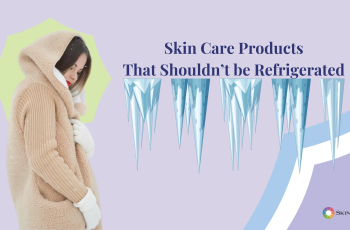
.webp)
.webp)
.webp)
Endocrine Disruptors and Hormones in Skincare Products: What You Need to Know
.webp)
.webp)
In recent years, awareness has grown about certain ingredients in personal care products, especially skincare, that may interfere with the body’s hormone system.
.webp)
.webp)
.webp)
These substances are called endocrine disruptors because they can affect hormones like estrogen, testosterone, and thyroid hormones.
.webp)
.webp)
Endocrine disruptors can mimic or block natural hormones, disrupting how our bodies work. Common suspects in skincare include parabens, phthalates, UV filters like benzophenones, soy extracts, and triclosan.
.webp)
.webp)
.webp)
And as research progresses, the list keeps growing.
.webp)
.webp)
But are these hormone-affecting ingredients harmful or helpful? The answer is—it depends. For example, estrogen-stimulating ingredients might benefit menopausal skin with low estrogen.
.webp)
.webp)
.webp)
However, during pregnancy, breastfeeding, or hormone-sensitive cancer, these ingredients could be risky.
.webp)
.webp)
This article explores hormone-active ingredients in skincare, how they work, who should be cautious, and what to avoid.
.webp)
.webp)
.webp)
Understanding Hormones in Skincare: What We Know and What We Don’t
.webp)
.webp)
Some skincare ingredients can penetrate the skin and activate hormone receptors, acting as “agonists.” An estrogen agonist binds estrogen receptors and triggers similar effects as natural estrogen would.
.webp)
.webp)
.webp)
Conversely, antagonists block hormone activity. For example, an estrogen antagonist prevents estrogen from acting on its receptors.
.webp)
.webp)
While this is the basic science, what remains unclear is the strength and long-term impact of these effects on skin and overall health.
.webp)
.webp)
.webp)
Long-term studies on skincare endocrine disruptors simply haven’t been done yet. Many of these ingredients have been used for years without clear evidence of harm, but uncertainty remains.
.webp)
.webp)
If you’re trying to conceive, going through puberty, or have hormone-sensitive tumors, it’s sensible to avoid these ingredients as a precaution.
.webp)
.webp)
.webp)
Lab and Animal Studies: What They Tell Us—and What They Don’t
.webp)
.webp)
Cell culture and animal experiments provide early clues about potential hormone disruption. But applying these findings directly to humans has major limitations.
.webp)
.webp)
.webp)
In lab tests, animals often receive very high doses—much higher than humans get from daily skincare use. Plus, species differences mean results in mice may not predict human effects accurately.
.webp)
.webp)
For example, mice metabolize chemicals faster and don’t accumulate them like humans might over decades. Also, lab studies often don’t mimic real-life product use patterns—low doses, applied sporadically.
.webp)
.webp)
.webp)
Because of these gaps, it’s hard to know if hormone-like effects seen in labs translate to meaningful health risks in people using skincare daily over years. More long-term human data is needed.
.webp)
.webp)
Who Should Be Cautious About Hormones in Skincare?
.webp)
.webp)
.webp)
Certain groups face higher risks from hormone-disrupting skincare ingredients. These include:
.webp)
.webp)
Pregnant or breastfeeding individuals, Infants and children undergoing development, Teens in puberty, People planning to conceive, Those with fertility challenges
.webp)
.webp)
.webp)
Individuals with hormone-responsive cancers (breast, uterine, ovarian)
.webp)
.webp)
People undergoing gender reassignment
.webp)
.webp)
.webp)
If you fall into any of these categories, it’s wise to avoid estrogen agonists and other endocrine disruptors in your skincare products.
.webp)
.webp)
What Are Endocrine Disruptors?
.webp)
.webp)
.webp)
An endocrine disruptor is a chemical that interferes with the body’s hormonal system. Hormones regulate vital functions like metabolism, reproduction, growth, and tissue function.
.webp)
.webp)
Endocrine disruptors may mimic hormones, block them, or alter hormone signaling. This can disturb the delicate balance essential for health.
.webp)
Safety and Risk Considerations
Exposure to endocrine disruptors, even in small amounts, may raise concerns about developmental, reproductive, and long-term health effects.
Hormones work on delicate feedback loops, so even subtle disruptions might matter.
That said, no long-term studies definitively prove skincare endocrine disruptors cause harm. Evidence-based trials are lacking.
Still, avoiding hormone-affecting ingredients during pregnancy, breastfeeding, or hormone-sensitive conditions is prudent.
Some endocrine disruptors also accumulate in the environment, affecting wildlife and ecosystems. But this article focuses on human hormonal effects from skincare ingredients only.
Hormones in Prescription vs. Cosmetic Products
Prescription topical hormones, like estrogen or testosterone creams, effectively penetrate skin and bloodstream to treat menopause or low testosterone symptoms. These drugs undergo rigorous safety testing.
In contrast, cosmetic skincare ingredients that interact with hormones are not required by the FDA to prove long-term safety or endocrine effects. This regulatory gap means risk assessment is less certain.
Common Endocrine Disruptors in Skincare
Here’s a list of common hormone-disrupting ingredients found in many personal care products:
Parabens (methyl-, ethyl-, propyl-, butylparaben), Benzophenones (oxybenzone, sulisobenzone), Phthalates (dimethyl, diethyl, dibutyl phthalate)
Triclosan, Octinoxate, Homosalate, Octocrylene, Paraffin and mineral oils, BHA & BHT preservatives, Formaldehyde and formaldehyde releasers, Fragrance and parfum (often undisclosed chemicals)
Retinyl palmitate, Soy extracts (glycine soja), Genistein and daidzein (soy isoflavones), Resorcinol, Hydroquinone, Certain dyes and colorants
Choosing Estrogen-Free and Hormone-Free Skincare
To avoid estrogen or hormone-active ingredients, carefully read product labels. Many “clean beauty” products claim to be free of endocrine disruptors, but definitions vary widely.
Common ingredients to avoid if seeking estrogen-free products include:
Parabens (all types)
Certain chemical sunscreens like oxybenzone and avobenzone
Synthetic dyes such as Blue 1 Lake and D&C Red 33
Fragrance components like musk tibetene
Safe Estrogenic Ingredients in Skincare
Some ingredients act as mild, safe estrogen agonists and can help menopausal or estrogen-deficient skin. These include:
Soy extracts (with some caveats), Genistein, Resveratrol, Methyl estradiolpropanoate (MEP), Methyl Estradiolpropanoate (MEP)
MEP is a synthetic, topical estrogen receptor activator used in products like Emepelle to treat estrogen-deficient skin in postmenopausal women.
Though it mimics estrogen locally in skin, MEP metabolizes quickly into inactive compounds once absorbed, avoiding systemic hormone effects.
Clinical studies show it is effective and safe without reproductive risks.
Soy in Skincare: Fermented vs. Unfermented
Not all soy extracts have the same hormonal activity.
Unfermented soy (soy milk, tofu, soy flour) contains high isoflavones with stronger estrogenic effects.
Fermented soy (tempeh, miso, soy sauce) has reduced isoflavones, showing minimal estrogenic activity.
Soy phospholipids (like soy lecithin) and certain soy proteins (STI and BBI) have minimal endocrine activity and are generally safe.
Resveratrol
Resveratrol, found in grape skins and berries, is a phytoestrogen with weak estrogen-like effects in lab studies.
Topical skincare doses likely have minimal hormonal impact due to limited skin absorption. Oral supplements in high doses may pose more risk but require more research.
Genistein
Genistein, an abundant soy isoflavone, activates certain estrogen receptors and may influence reproductive functions.
High doses show complex effects on ovarian and testicular health in animals. Human effects are less clear but warrant caution in sensitive groups.
Phytoestrogens: Natural Plant Estrogens
Phytoestrogens are plant-based compounds that mimic estrogen. Common examples include:
Genistein and daidzein (soy), Coumestrol (clover), Formononetin and biochanin A (red clover), Quercetin (fruits, vegetables), Resveratrol (grapes, berries), Lignans (flaxseed)
These compounds naturally occur in many foods and some skincare ingredients.
Final Thoughts: Stay Informed and Choose Wisely
Many cosmetic ingredients with hormone activity are safe for most people, but uncertainties remain, especially for sensitive groups.
Research is ongoing, and ingredient safety needs regular reassessment. If you’re pregnant, breastfeeding, or have hormone-related health issues, avoid hormone-active skincare ingredients as a precaution.
For personalized advice, identify your Baumann Skin Type using our skin quiz. This helps you discover which ingredients fit your unique skin needs best.
Stay updated by following trusted sources and approaching skincare ingredient claims with a critical eye.



